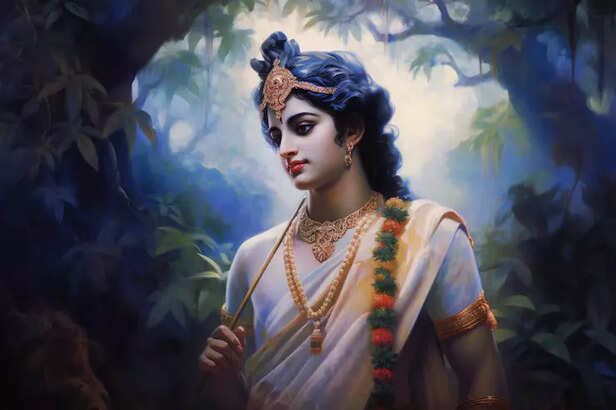Feeling Torn Between Duty and Emotion? Discover the Gita’s Guidance
Amritansh Nayak | May 05, 2025, 14:21 IST
learning from gita
( Image credit : Freepik )
This article examines how the teachings of the Bhagavad Gita, specifically those related to dharma, doubt, and Nishkama Karma, can assist us in resolving contemporary moral quandaries. It provides useful advice for making moral choices in today's complicated world with clarity, bravery, and objectivity by drawing from Arjuna's predicament.
More than just old scripture, the Bhagavad Gita—a spiritual classic delivered on the battlefield—is a manual for navigating the most difficult decisions of our day. From Krishna's teachings on responsibility, uncertainty, and detachment to Arjuna's moral dilemma, the Gita provides deep insight into the internal struggles we all encounter. This article examines how its timeless wisdom can clearly and profoundly light our way through contemporary problems.

The Bhagavad Gita begins on the Kurukshetra battlefield, where two branches of the same royal family are at odds right before war breaks out. Beneath the clashing armies, however, is a more profound and personal struggle—the psychological struggle of Arjuna, the renowned warrior, who is suddenly paralyzed by uncertainty. Arjuna lowers his bow and considers the ethics of his conduct when he is faced with the possibility of fighting his own family, friends, and teachers. Should he follow his kshatriya duty as a warrior or pay attention to his hurting heart that shudders at the carnage?
This striking image turns the battlefield into a timeless metaphor for the internal conflicts that all people experience—the times when morals collide, when duty and compassion seem to be at odds, and when taking action seems both necessary and intolerable. The general human experience of moral ambiguity—being drawn in many directions by duty, emotion, and ethical uncertainty—is reflected in Arjuna's reluctance. Krishna doesn't provide a straightforward response. Rather, the Gita transforms the occasion into an in-depth philosophical discussion about self, righteousness, and purpose. A spiritual awakening takes place against the backdrop of the physical war, prompting us to consider how we ourselves deal with the internal conflicts.

The core of Arjuna's internal struggle in the Bhagavad Gita is the idea of dharma. Dharma, which is frequently interpreted as "duty" or "righteousness," is much more nuanced than a rigid set of moral precepts. It includes a person's obligations according to their social position, life stage, and individual temperament. As a warrior, Arjuna is compelled by his dharma to fight for justice, even if it means going up against loved ones. His heart, however, rebels, exposing the conflict between communal duty and private feeling. Dharma is not presented in the Gita as a universal set of rules. Rather, it handles it as a context-sensitive, dynamic compass.
What works for one individual at a given time might not work for another. Krishna highlights that doing one's own responsibility, is more important than flawlessly carrying out someone else's obligation. This emphasizes how crucial context, self-awareness, and honesty are when making moral decisions. From this perspective, dharma is seen as a means of achieving inner harmony and spiritual development rather than merely a duty. It challenges us to consider not just what we do but also why we do it, as well as whether our activities further our inner purpose, truth, and harmony.
In the Bhagavad Gita, Arjuna's crisis starts with doubt—a profound, unnerving ambiguity about what is right—rather than failure. He ponders the ethics of killing his family members out of duty as he stands between two armies. His body trembles, his mind is overpowered, and his bow slips from his hands. The Gita portrays Arjuna's hesitancy as a necessary period of reflection—a pause before blind action—rather than as a sign of weakness. The philosophy of the Gita acknowledges doubt as a path to insight rather than condemning it. Krishna doesn't brush off Arjuna's enquiries. Rather, he interacts with them, helping him navigate layers of accountability, truth, and self-awareness.
The tension between obligation and conscience opens up a space for change, where decisions are made consciously and from a place of greater awareness rather than out of fear, attachment, or blind tradition. According to the Gita, clarity emerges when doubt is bravely and thoughtfully faced rather than avoided. Arjuna's journey serves as a reminder that moral ambiguity is a natural part of the human experience and that true strength comes from asking probing questions, getting advice, and acting in accordance with our best knowledge.

Nishkama Karma, or doing one's duty without caring about the results, is one of the main lessons of the Bhagavad Gita. As a warrior, Krishna exhorts Arjuna to follow his dharma without letting his fear of losing or his desire for victory control him. This idea turns into a cure for moral paralysis, which is the condition in which significant action is thwarted by uncertainty, anxiety, and overanalyzing. Nishkama Karma opposes apathy and indifference. Rather, it urges complete commitment to doing the right thing while letting go of the impulse to manipulate outcomes. Our decisions are influenced by emotional attachment, fear of losing something, or personal gain when we are tied to particular results.
However, we are free from anxiety and internal conflict when we act with clarity and selflessness. This lesson provides strong direction for negotiating morally difficult situations. We frequently hesitate to take action because we cannot foresee the outcomes or because every choice requires some sort of sacrifice. According to the Gita, doing the right thing with honesty and objectivity will reward itself. We acquire the bravery to proceed and the composure to handle any situation when we let go of the outcomes.
Even though the Bhagavad Gita was uttered on a battlefield in antiquity, its lessons are remarkably applicable to contemporary society. Even while today's problems don't necessarily involve actual conflict, they frequently call for making difficult decisions on moral employment, family obligations, environmental concerns, and personal beliefs. Dharma, according to the Gita, is a living principle that requires one to behave with awareness, authenticity, and harmony with the truth rather than as a set norm. In the modern world, upholding justice even when it is inconvenient, choosing a career that is in line with one's ideals rather than just financial gain, or striking a balance between ambition and compassion are all examples of living one's dharma.
According to the Gita, these choices are not always straightforward, but they can become evident with introspection, a clear aim, and the guts to act without regard for the results. A useful anchor is provided by Nishkama Karma: give your all to your obligations while letting go of your compulsive control over the outcome. This way of thinking improves inner stability and lowers stress. The Gita encourages us to serve with honesty and objectivity, regardless of our profession—teacher, activist, parent, or artist.
In the end, practicing dharma now is making thoughtful, kind decisions in a noisy world—driven by more knowledge rather than fear or want. Every choice is an opportunity for development, as the Gita reminds us. We can connect our lives with a greater purpose by comprehending dharma, accepting doubt, and acting without attachment. The teachings of the Gita lead us not only to action but also to smart, thoughtful, and compassionate living in a chaotic environment, whether in the areas of employment, relationships, or social responsibility.
Explore the latest trends and tips in Health & Fitness, Travel, Life Hacks, Fashion & Beauty, and Relationships at Times Life!

learn decision making
Kurukshetra's Battlefield: An Allegory for Internal Struggle
This striking image turns the battlefield into a timeless metaphor for the internal conflicts that all people experience—the times when morals collide, when duty and compassion seem to be at odds, and when taking action seems both necessary and intolerable. The general human experience of moral ambiguity—being drawn in many directions by duty, emotion, and ethical uncertainty—is reflected in Arjuna's reluctance. Krishna doesn't provide a straightforward response. Rather, the Gita transforms the occasion into an in-depth philosophical discussion about self, righteousness, and purpose. A spiritual awakening takes place against the backdrop of the physical war, prompting us to consider how we ourselves deal with the internal conflicts.

control your emotions
Dharma : What Is It? Duty Layers in the Gita
What works for one individual at a given time might not work for another. Krishna highlights that doing one's own responsibility, is more important than flawlessly carrying out someone else's obligation. This emphasizes how crucial context, self-awareness, and honesty are when making moral decisions. From this perspective, dharma is seen as a means of achieving inner harmony and spiritual development rather than merely a duty. It challenges us to consider not just what we do but also why we do it, as well as whether our activities further our inner purpose, truth, and harmony.
The Function of Doubt in the Intersection of Duty and Conscience
The tension between obligation and conscience opens up a space for change, where decisions are made consciously and from a place of greater awareness rather than out of fear, attachment, or blind tradition. According to the Gita, clarity emerges when doubt is bravely and thoughtfully faced rather than avoided. Arjuna's journey serves as a reminder that moral ambiguity is a natural part of the human experience and that true strength comes from asking probing questions, getting advice, and acting in accordance with our best knowledge.

learnings from geeta
Take Action Without Attachment: The Gita's Solution for Moral Insomnia
However, we are free from anxiety and internal conflict when we act with clarity and selflessness. This lesson provides strong direction for negotiating morally difficult situations. We frequently hesitate to take action because we cannot foresee the outcomes or because every choice requires some sort of sacrifice. According to the Gita, doing the right thing with honesty and objectivity will reward itself. We acquire the bravery to proceed and the composure to handle any situation when we let go of the outcomes.
Living Dharma in the Present
According to the Gita, these choices are not always straightforward, but they can become evident with introspection, a clear aim, and the guts to act without regard for the results. A useful anchor is provided by Nishkama Karma: give your all to your obligations while letting go of your compulsive control over the outcome. This way of thinking improves inner stability and lowers stress. The Gita encourages us to serve with honesty and objectivity, regardless of our profession—teacher, activist, parent, or artist.
In the end, practicing dharma now is making thoughtful, kind decisions in a noisy world—driven by more knowledge rather than fear or want. Every choice is an opportunity for development, as the Gita reminds us. We can connect our lives with a greater purpose by comprehending dharma, accepting doubt, and acting without attachment. The teachings of the Gita lead us not only to action but also to smart, thoughtful, and compassionate living in a chaotic environment, whether in the areas of employment, relationships, or social responsibility.
Explore the latest trends and tips in Health & Fitness, Travel, Life Hacks, Fashion & Beauty, and Relationships at Times Life!
